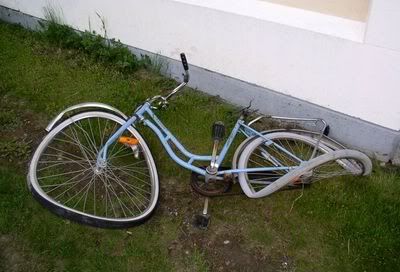Author's posts
Jun 29 2009
Occasional Bike Blogging: Fixing Broken Cables with the Internet
 Disclaimer: I don’t know what the hell I am doing, so this is not a How To. Actually, getting this done despite not knowing what the hell I am doing is kind of the point.
Disclaimer: I don’t know what the hell I am doing, so this is not a How To. Actually, getting this done despite not knowing what the hell I am doing is kind of the point.
A couple of weeks ago, I finally got serious about trying to get my rear derailleur back into action. It had seized up during the winter, and while I got some rear gears back at that time, I was down to three speeds on the front derailleur again.
So I was trying the dry lube, working it in on all joints, working the derailleur mechanism, and cleaning off the crud it was bringing up. Except no matter how progress I seemed to make, when I went to shift it, it seized up again. And then another round.
Until the cable snapped.
Fudge, now I had to change the cable. So I hit the internet to try to see what is involved with changing the cable. One of the first hits I got told me that when a derailleur is sticking, its normally the cable rather than the derailleur mechanism.
Aha, that sounded right. Lesson One: check the intertubes for advice first, before getting started on a new job.
{keep on with the cable repair after the break}
Jun 16 2009
A Brawny Recovery Instead of Unsustainable Consumption-Led Growth
Burning the Midnight Oil for a Brawny Recovery
 On Agent Orange, bonddad writes:
On Agent Orange, bonddad writes:
Among the most important of the rules Rosie laid down, in my opinion, is #12: Get the US consumer right and everything else will take care of itself. The reason is fairly simple: The U.S. consumer has the biggest balance sheet on the planet. The U.S. consumer represents 70 percent of our GDP and about 18 percent of global GDP.
This is, however, following the entrenched habits of thought that got us into this mess in the first place. My reply, below the fold.
Jun 14 2009
Beware of Geeks bearing VATs
Burning the Midnight Oil for a Brawny Recovery, cross-posted from My Left Wing.
 If you wander around the fringes of economic discussion on these Interwebs, you may encounter sites extolling the wondrous virtues of the VAT. “If only we would adopt a massive VAT, our two decade long decline in manufacturing output would be gone, and we would be an exporting powerhouse once again.” … well, no, that would be a stereotyping of the argument. A real sample of the claims sound more like this, from tradereform.org:
If you wander around the fringes of economic discussion on these Interwebs, you may encounter sites extolling the wondrous virtues of the VAT. “If only we would adopt a massive VAT, our two decade long decline in manufacturing output would be gone, and we would be an exporting powerhouse once again.” … well, no, that would be a stereotyping of the argument. A real sample of the claims sound more like this, from tradereform.org:
I Squared R Element Company is in Akron, New York. It makes industrial heating elements which are used for many processes to make other things, including glass and computer chips. The company was the low bidder on a contract to export to China.
However, the company lost the bid. Why?
I squared R was told it did not include, in its bid, China’s 10% customs duty or the 17% value added tax(VAT) that must be paid at the border.
All our goods pay a 17% VAT at the Chinese border. And the uninformed say we are a high cost producer. Chinese exporters also get a 17% VAT rebate, i.e. they get paid to export.
And, yes, I have picked out this quote to pick on VAT-uber-alles advocates, precisely because it focuses on the part of the argument that is simply wrong.
More below…
Jun 01 2009
What Can Newspaper Reporting Learn from Yuricon?
.. and from Yuri Monogatari 6?
That is to say:
Well, that’ll take time to explain, and it will be speculative even once explained. But as newspapers are dying like flies … newspaper reporting may have something to learn from micro-niche publishers like the publisher of YM6.
May 25 2009
So that we won’t need a Memorial Day for the US economy
 … or perhaps that should be, so we no longer need a memorial day for the US economy.
… or perhaps that should be, so we no longer need a memorial day for the US economy.
In It need not be a calamity, I wrote:
But … well, we know this. We have known since the 1970’s that we would become increasingly dependent under the Old Energy Economy. We have known since the 1970’s that our four centuries of energy self-sufficiency since European Settlement of the eastern seaboard of North America would be coming to an end unless we made substantial changes.
And then our ruling elites collectively decided to pretend that social division of national product is a more fundamental question than the ability to continue producing it, and we descended into the last thirty years of the wealthy focusing in grabbing a bigger share of the pie, while assuming that the baking of the pie would magically take care of itself.
Crossposted from Burning the Midnight Oil for a Brawny Recovery and The Economic Populist
May 21 2009
Redemption Songs
May 20 2009
It Need Not Be a Calamity
 Betwixt and Between, I find myself. I observe the validity of D00m.P0rn shrill warnings about the future … when seen as possible outcomes rather than when seen as certainties. Yet I also see the potential for better outcomes.
Betwixt and Between, I find myself. I observe the validity of D00m.P0rn shrill warnings about the future … when seen as possible outcomes rather than when seen as certainties. Yet I also see the potential for better outcomes.
And with respect to the strategy of sitting on the sidelines, weighing the likelihood of one versus the other … I’m against it. Simply the decision to sit on the sidelines makes the calamity more likely as a result. So I am for getting into the fray and trying to make the calamity less likely and the hopeful outcome more likely.
The Calamity Cavalcade
As far as potential calamities, we do not have to look far for those.
We are on track to have a higher concentration of CO2 in the atmosphere than at any other time in the Holocene. We are engaged in this experiments with absolutely no serious evidence to suggest that it is known to be safe. Indeed, those benefiting in the short term from the reckless experiment will even try to reverse the sane burden of proof and place it on those who do not approve of undertaking the reckless experiment.
The argument being, in essence, that if you are driving through a thick fog, then as long as you don’t see any cars coming, its OK to speed.
And of course, before the peril of climate chaos came to our attention, there was already the risk of ecosystem collapse hanging over our head, as more and more populations on the planet rely on an industrial technology that is quite clearly ecologically unsustainable and therefore certain to collapse sooner or later, unless we restructure our technological base to approach sustainability faster than we approach ecosystem collapse.
And then of course, even before the risk of ecosystem collapse was widely understood, the threat of nuclear holocaust.
Flood, Nuclear fire followed by Nuclear Winter, Famine and Plague … and all three involved in or certainly leading to War … surely rather than Four Horsemen of the Apocalypse, there is a whole Cavalry Unit.
Against that backdrop, it may seem provincial to worry about a mere collapse of a single national economy from first world to banana republic status, but that is the specific calamity that I am focusing on here.
May 10 2009
The Bad News and the Worse News on Unemployment.
 The April employment numbers are out. The Broad Based (U6) unemployment figures … the best measure of the “total people available to take on more work” … give, on the one hand, bad news, and on the other hand, worse news. This is, of course, treated as “good news”, because the expectation was that it would be on the one hand worse news and on the other hand catastrophic news.
The April employment numbers are out. The Broad Based (U6) unemployment figures … the best measure of the “total people available to take on more work” … give, on the one hand, bad news, and on the other hand, worse news. This is, of course, treated as “good news”, because the expectation was that it would be on the one hand worse news and on the other hand catastrophic news.
.
..
…
..
.
| U6 seasonally adjusted | JAN | FEB | MAR | APR | MAY | JUN | JUL | AUG | SEP | OCT | NOV | DEC |
| 2008 | 9.0% | 8.9% | 9.1% | 9.2% | 9.7% | 9.9% | 10.3% | 10.9% | 11.2% | 12.0% | 12.6% | 13.5% |
| 2009 | 13.9% | 14.8% | 15.6% | 15.8% |
This is not the “headline” rate, or U3, which takes everyone working any hours at all as “employed”, even if they want more work, and anyone who has not actively sought work in the last four weeks is dropped out altogether.
Instead, its the “broad” or “U6” rate, where those who express an interest in working who have looked for work in the past year are included, as well as those who are “involuntary part-time” employees. So the U6 series is the best measure of the “total people available to take on more work”.
Also note that BLS unemployment statistics are not determined by the numbers of people drawing unemployment … it includes a broad range of data sources, including an ongoing telephone survey.
In terms of changes in the “U6” unemployment rate, this is:
| Change in U6 | JAN | FEB | MAR | APR | MAY | JUN | JUL | AUG | SEP | OCT | NOV | DEC |
| 2008 | -0.1% | +0.2% | +0.1% | +0.5% | +0.2% | +0.4% | +0.6% | +0.3% | +0.8% | +0.6% | +0.9% | |
| 2009 | +0.4% | +0.9% | +0.8% | +0.2% |
The bad news is, of course broad based unemployment is still rising. The worse news is that it is more than halfway to the “depths of the Great Depression” benchmark of around 1 in 4 out of work.
Even more, the populace has been trained to accept as “normal” unemployment rates what would have been considered an economic emergency back in the 1960’s.
Apr 29 2009
‘run ads with fancy graphics to show we care …
… while we’re lobbying politicians to punch the treaty full of loopholes”.
script(pdf) (script below the fold)
AVAAZ.org‘s “Stop Climate Spin” campaign.
AVAAZ has the hat out to raise the money to get the ad on heavy rotation at CNN. Also, if you can donate views, ratings, favorites and comments at Youtube, that’s another way to raise the profile.
(h/t A Siegel at Agent Orange)
Apr 26 2009
What’s in SUPERTRAINS for Small Town and Rural America?
Crossposted from Hilbilly Report
 This last weekend I wrote up a small diary, cross-posted to various places … which even stumbled into being wrecklisted at Agent Orange … about the High Speed Rail plan released by the Obama administration.
This last weekend I wrote up a small diary, cross-posted to various places … which even stumbled into being wrecklisted at Agent Orange … about the High Speed Rail plan released by the Obama administration.
That diary focused on laying out the three “tiers” of HSR in the announced plan. “Express HSR” is one of the bullet train systems, like they are planning for California. But between that tier and conventional rail, are two more tiers:
- “Regional HSR”, with a top speed of around 125mph, able to provide trips at average speeds in the range of 100mph, operating in existing rail rights of way, but mostly on its own track, with upgraded signaling and substantial investment in grade separation and/or the top level of “hardened” level crossings, normally with electrified lines; and
- “Emerging HSR”, with a top speed of 110mph, able provide trips at average speed in excess of 80mph, operating on existing rail right of way with improved capacity, but sometimes sharing track with freight rail, the 110mph standard of quad gate, speed sensitive level crossings, and provided by either electric or diesel 110mph tilt-trains
The bullet trains are the show ponies … but for small town and rural America, the genuine seat at the table for Emerging and Regional HSR is the real good news from the announcement.
Apr 18 2009
How To Build a National High Speed Rail system
Burning the Midnight Oil for Living Energy Independence
 … A Four Step Program
… A Four Step Program
Step 1. Give states a framework to develop plans, either individually or in groups, and present them to the Federal government for vetting, approval, and funding support.
Step 2. States do that.
Step 3. Fund a substantial number of seed corridors, so that a large number of metro areas (House) and States (Senate) have a stake in maintaining ongoing Federal HSR funding.
Step 4. Keep funding the construction of more.
That is my plan. But, OTOH, I’m just an obscure Development Economist with a field specialization in Regional Economics, so the fact that its my plan is neither here nor there.
More newsworthy, it seems to be the plan of the Obama administration. So, unlike the Bank Bail-out, I find myself on the “cheerleader” side of Administration activity.
Give Me an H! Give Me an S! Give Me an R! What’s It Spell? One Piece of the Energy Independent Transport Puzzle! YEAH!!!!
Apr 12 2009
Amazonfail: Amazon dropping ‘adult’ content from rankings.
![]() I just saw this post at a site that I frequent(*),:
I just saw this post at a site that I frequent(*),:
Amazon De-ranks “Adult” Books
This is not a crisis, nor should we run screaming, but I think it is important enough that every reader, writer, publisher, editor and all champions of freedom of expression should take note. Amazon has changed its policy and has de-ranked books that it deems “adult” in nature. This includes anything they count as erotica and many non-adult LGBT books, as well. De-ranking means that they have been pulled from the sales ranks and are also not coming up in the search engine.
(and this particular euphemism always amuses me … dropping adult content rankings? That means only children are supposed to refer to Amazon ratings?)
